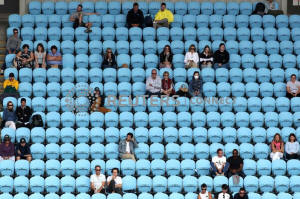Game, set and mask: fans trickle in on first day of Australian Open
 Send a link to a friend
Send a link to a friend
 [February 08, 2021] [February 08, 2021]
By Melanie Burton
MELBOURNE (Reuters) - Tennis fans wearing
masks filtered into Melbourne Park on Monday for the start of the
Australian Open, this year's first Grand Slam event, as the host city
recorded one new locally transmitted case of the novel coronavirus.
Players and staff arriving from overseas have all served 14 days of
quarantine but foreign fans have been kept out as part of Australia's
tough and effective measures to get to grips with the coronavirus.
The tournament will welcome about half its usual capacity, with crowds
limited to 30,000 fans a day, at its sprawling site divided into three
distinct zones around the main showcourts named after Australian tennis
greats Margaret Court and Rod Laver, and former state leader John Cain.
There was no rush of spectators on Monday and it was not clear if it was
the overcast sky and 17 Celsius (62.6 Fahrenheit) temperature or
coronavirus concerns keeping people away.

Organisers, expecting a slow start to the two-week championships, said
17,922 fans passed through the gates on Monday compared to 64,387 on day
one last year.
While bushfire smoke was the main concern in 2020, health and safety are
the watchwords this year with masks, physical distancing and
contact-tracing at the ready to stem any outbreak.
More than 800 hand sanitizer dispensers have also been installed
together with QR code checks, click and collect for food and drinks and
daily deep cleaning.
"This year it has been all about making sure when our fans come on site
they feel safe," Tennis Australia's Chief Operating Officer Tom Larner
told reporters on the eve of the event.
"The zones are set up to make sure that if we did have any positive
cases on site, we can really quickly and accurately track who has been
in that area."
Australia has been more successful in combating the coronavirus than
many other countries with 28,800 cases over the past year and 909
deaths, largely as a result of its decisive lockdowns and border
closures.
[to top of second column] |

Fans watch the first
round match between Germany's Alexander Zverev and Marcos Giron of
the U.S.. Crowd capacity for this years event has been capped at
30,000 per day following the outbreak of the coronavirus disease
(COVID-19) REUTERS/Asanka Brendon Ratnayake

'DOING GREAT'
That success has set the stage for the third Grand Slam of the
pandemic, but the first to allow big crowds after the U.S. and
French Opens passed safely enough but with largely empty stadiums.
But warm-up tournaments that packed out stadiums across Australia a
year ago have drawn tiny crowds to Melbourne Park over the past
week, even with the game's biggest stars in action after completing
their quarantine.
Undaunted fan Boris Trbojevic, 30, travelled 1,700 km from the city
of Brisbane to watch the tennis for a few days and was not worried
about the coronavirus or getting caught up in a lockdown if a
cluster of cases were to appear.
"It's a risk, but that's the way it is," he said.
"Australia as a country has been doing great. Just one new case
overnight ... but it's one case out of 25 million people."
Karen Orelli, 52, and sister Megan Batrouney, 50, said while things
weren't as cheerful as they usually are, the coronavirus virus
restrictions meant things weren't so crowded.
"We can sit together but there are two seats between us and the next
people," Orelli said.
"It's good because you can get around, you can get onto all the
courts, you can see whatever you want."
Australia reported just one locally transmitted case of COVID-19 on
Monday, in Melbourne - linked to a quarantine hotel not associated
with the tennis.
Neighbouring New South Wales state was investigating another case in
a returned traveller who tested positive after leaving hotel
quarantine.
(Reporting by Melanie Burton; Editing by Robert Birsel and Pritha
Sarkar)
[© 2021 Thomson Reuters. All rights
reserved.] Copyright 2021 Reuters. All rights reserved. This material may not be published,
broadcast, rewritten or redistributed.
Thompson Reuters is solely responsible for this content. |